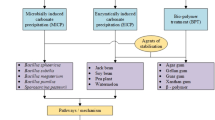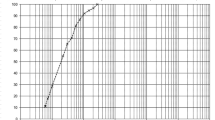Abstract
Development and use of non-traditional stabilizers such as enzyme and alkali-activated ground granulated blast-furnace slag (GGBS) for soil stabilization helps to reduce the cost and the detrimental effects on the environment. The objective of this study is to investigate the effectiveness of alkali-activated GGBS and enzyme as compared to ordinary Portland cement (OPC) on the soil collected from Tilda region of Chhattisgarh, India. Geopolymers are alkali alumino-silicates produced when combining a solid alumina-silicate with an aqueous alkali hydroxide or silicate solution. Various dosages of the selected stabilizers have been used and evaluated for the effects on optimum moisture content (OMC), maximum dry density, plasticity index, unconfined compressive strength (UCS) and shear strength parameters. Effect of curing period has also been studied. Microstructural changes of the stabilized soils show aggregation of particles. Significant improvement in properties of soil is observed with the addition of stabilizers leading to an increase in OMC, UCS and shear strength parameters. It is observed that the cohesion of soil sample increases significantly with the addition of stabilizers whereas there is a marginal change in angle of internal friction. Thus, the findings recommend the use of non-conventional stabilizer such as alkali-activated GGBS and enzyme as suitable and environmental friendly as compared to OPC for soil stabilization.
Similar content being viewed by others
References
Asgari, M.R.; Dezfuli, A.B.; Bayat, M.: Experimental study on stabilization of a low plasticity clayey soil with cement/lime. Arab. J. Geosci. 8, 1439–1452 (2013)
Azari, B.; Fatahi, B.; Khabbaz, H.: Assessment of the elastic–viscoplastic behavior of soft soils improved with vertical drains capturing reduced shear strength of a disturbed zone. Int. J. Geomech. ASCE 16, 1532–3641 (2014)
Parsa-Pajouh, A.; Fatahi, B.; Khabbaz, H.: Experimental and numerical investigations to evaluate two-dimensional modeling of vertical drain-assisted preloading. Int. J. Geomech. ASCE 16, 1532–3641 (2015)
Higgins, D.: GGBS and sustainability. Constr. Mater. 160(3), 99–101 (2007)
Rahman, A.: Stabilisation of clay subgrade soils using stabilisation. Ph.D. thesis, University of Leeds (2001)
Nguyen, L.; Fatahi, B.; Khabbaz, H.: Development of a constitutive model to predict the behavior of cement-treated clay during cementation degradation: C3 model. Int. J. Geomech. ASCE 17, 1532–3641 (2017)
Nguyen, L.; Fatahi, B.: Behaviour of clay treated with cement & fibre while capturing cementation degradation and fibre failure—C3F model. Int. J. Plast. 81, 168–195 (2016)
Velasquez, R.; Marasteanu, O.M.; Hozalski, R.; Clyne, T.: Preliminary laboratory investigation of enzyme solutions as a soil stabilizer. Report no. MN/RC–2005-25, Department of Civil Engineering, Minnesota Department of Transportation Research, Minneapolis(2005)
Mitchell, J.K.; Soga, K.: Fundamentals of Soil Behavior, 3rd edn. Wiley, Hoboken (2005)
Sargent, P.: The development of alkali activated mixtures for soil stabilisation. In: Torgal, F.P., Labrincha, J., Leonelli, C., Palomo, A., Chindaprasit, P. (eds.) Handbook of Alkali-Activated Cements, Mortars and Concretes, pp. 555–604. AECOM, Altrincham (2015)
Chew, S.H.; Kamruzzaman, A.H.M.; Lee, F.H.: Physico- chemical and engineering behavior of cement treated clays. J. Geotech. Geoenviron. Eng. 130(7), 696–706 (2004)
Prusinski, J.R.; Bhattacharja, S.: Effectiveness of Portland cement and lime in stabilizing clay soils. Transp. Res. Rep. 1652, 215–227 (1999)
Jin, F.; Gu, K.; Al-Tabbaa, A.: Strength and hydration properties of reactive MgO-activated ground granulated blast furnace slag paste. Cem. Concr. Compos. 57, 8–16 (2015)
Khan, T.A.; Taha, M.R.: Effect of three bioenzymes on compaction, consistency limits, and strength characteristics of a sedimentary residual soil. Adv. Mater. Sci. Eng. 2015, 1–9 (2015)
Yi, Y.; Li, C.; Liu, S.: Alkali-activated ground-granulated blast furnace slag for stabilization of marine soft clay. J. Mater. Civ. Eng. 04014146, 1–7 (2014)
Rashad, A.M.: A comprehensive overview about the influence of different additives on the properties of alkali-activated slag—a guide for Civil Engineer. Constr. Build. Mater. 47, 29–55 (2013)
Khale, D.; Chaudhary, R.: Mechanism of geopolymerization and factors influencing its development: a review. J. Mater. Sci. 42, 729–46 (2007)
Mozumder, R.A.; Laskar, A.I.: Prediction of unconfined compressive strength of geopolymer stabilized clayey soil using artificial neural network. Comput. Geotech. 69, 291–300 (2015)
Shi, C.; Krivenko, P.V.; Roy, D.M.: Alkali-Activated Cements and Concretes. Taylor and Francis, London (2006)
Song, S.; Sohn, D.; Jennings, H.M.; Mason, T.O.: Hydration of alkali-activated ground granulated blast furnace slag. J. Mater. Sci. 35(1), 249–257 (2000)
Wang, S.; Scrivener, K.L.: Hydration products of alkali activated slag cement. Cem. Concr. Res. 25(3), 561–571 (1995)
Wu, X.; Jiang, W.; Roy, D.M.: Early activation and properties of slag cement. Cem. Concr. Res. 20, 961–974 (1990)
Yi, Y.; Gu, L.; Liu, S.: Microstructural and mechanical properties of marine soft clay stabilized by lime-activated GGBS. Appl. Clay Sci. 103, 71–76 (2015)
Yi, Y.; Liska, M.; Al-Tabbaa, A.: Properties and microstructure of GGBS–MgO pastes. Adv. Cem. Res. 26(2), 114–122 (2014)
Du, Y.; Yu, B.; Liu, K.; Jiang, N.; Liu, M.D.: Physical, hydraulic, and mechanical properties of clayey soil stabilized by lightweight alkali-activated slag geopolymer. J. Mater. Civ. Eng. ASCE 29(2), 1–10 (2014)
Du, Y.; Bo, Y.; Jin, F.; Liu, C.: Durability of reactive magnesia-activated slag-stabilized low plasticity clay subjected to drying-wetting cycle. Eur. J. Environ. Civ. Eng. 20, 215–230 (2015)
Yi, Y.; Gu, L.; Liu, S.; Jin, F.: Magnesia reactivity on activating efficacy for ground granulated blast-furnace slag for soft clay stabilisation. Appl. Clay Sci. 126, 57–62 (2016)
Cristelo, N.; Glendinning, S.; Fernandes, L.; Pinto, A.T.: Effects of alkaline-activated fly ash and Portland cement on soft soil stabilisation. Acta Geotech. 8, 395–405 (2013)
Sargent, P.; Hughes, P.N.; Rouainia, M.; White, M.: The use of alkali activated waste binders in enhancing the mechanical properties and durability of soft alluvial soils. Eng. Geol. 152, 96–108 (2013)
Tingle, J.S.; Newman, J.K.; Larson, S.L.; Weiss, C.A.; Rushing, J.F.: Stabilisation mechanisms of nontraditional additives. J. Transp. Res. Board 1989(2), 59–67 (2007)
Scholen, D.E.: Nonstandard stabilizers. Report FHWA-FLP-92-011, FHWA (1992)
Rauch, A.F.; Katz, L.E.; Liljestrand, H.M.: An analysis of the mechanisms and efficacy of three liquid chemical soil stabilizers. Research report 1993-1, Center for Transportation Research, University of Texas at Austin (2003)
Ganapathy, G.P.; Gobinath, R.; Akinwumi, I.I.; Kovendiran, S.; Thangaraj, M.; Lokesh, N.; Muhamed, A.S.; Arul, M.R.; Yogeswaran, P.; Hema, S.: Bio-enzymatic stabilization of a soil having poor engineering properties. Int. J. Civ. Eng. (2016). https://doi.org/10.1007/s40999-016-0056-8
Latifi, N.; Marto, A.; Eisazadeh, A.: Analysis of strength development in non-traditional liquid additive-stabilized laterite soil from macro- and micro-structural considerations. Environ. Earth Sci. 73, 1133–1141 (2015). https://doi.org/10.1007/s12665-014-3468-2
Latifi, N.; Rashid, A.S.A.; Siddiqua, S.; Horpibulsuk, S.: Micro-structural analysis of strength development in low- and high swelling clays stabilised with magnesium chloride solution—a green soil stabiliser. Appl. Clay Sci. 118, 195–206 (2015)
Eujine, G.N.; Chandrakaran, S.; Sankar N.: The engineering behaviour of enzymatic lime stabilised soils. In: Proceedings of the Institution of Civil Engineers Ground Improvement, pp. 1–11 (2016)
Gilazghi, S.T.; Huang, J.; Rezaeimalek, S.; BinShafique, S.: Stabilizing sulfate-rich high plasticity clay with moisture activated polymerization. Eng. Geol. 211, 171–178 (2016)
Moloisane, R.J.; Visser, A.T.: Evaluation of the strength behaviour of unpaved road material treated with electrochemical-based non-traditional soil stabilisation additives. J.S. Afr. Inst. Civ. Eng. 56(1), 28–39 (2014)
Kestler, M.A.: Stabilisation selection guide for aggregate and native-surfaced low-volume roads. National Technology and Development Program, Forest Service, U.S. Department of Agriculture, Washington, DC (2009)
IS 4332-1: Methods of test for stabilized soils: method of sampling and preparation of stabilized soils for testing. Bureau of Indian Standards, New Delhi (1967–Reaffirmed 2010)
ASTM D 1632-96: Standard practice for making and curing soil-cement compression and flexure test specimens in the laboratory. Annual Book of ASTM Standards, West Conshohocken, PA (2002)
IS: 2720-5: Methods of tests for soils: determination of liquid and plastic limit. Bureau of Indian Standards, New Delhi (1985–Reaffirmed 2006)
ASTM D 4318-00: Standard test methods for liquid limit, plastic limit, and plasticity index of soils. Annual Book of ASTM Standards, West Conshohocken, PA (2002)
IS: 2720-8: Methods of tests for soils: determination of water content, dry density relation of soil using heavy compaction. Bureau of Indian Standards, New Delhi (1983–Reaffirmed 2006)
ASTM D 1557: Standard test methods for laboratory compaction characteristics of soil using modified effort. ASTM Standards, West Conshohocken, PA (2007)
IS: 2720-10: Methods of tests for soils: determination of unconfined compressive strength of soil. Bureau of Indian Standards, New Delhi (1991–Reaffirmed 2006)
ASTM D 2166-00: Standard test method for unconfined compressive strength of cohesive soil. Annual Book of ASTM Standards, West Conshohocken, PA (2002)
IS 2720-11: Methods of tests for soils: Determination of shear strength parameters of a specimen tested in unconsolidated undrained triaxial compression without the measurement of pore water pressure. Bureau of Indian Standards, New Delhi (1993–Reaffirmed 2002)
ASTM D 2850-03a: Standard test method for unconsolidated-undrained triaxial compression test on cohesive soils. Annual Book of ASTM Standards, West Conshohocken, PA (2006)
Goodarzi, A.R.; Salimi, M.: Stabilization treatment of a dispersive clayey soil using granulated blast furnace slag and basic oxygen furnace slag. Appl. Clay Sci. 108, 61–69 (2015)
Marto, A.; Latifi, N.; Sohaei, H.: Stabilisation of laterite soil using GKS soil stabiliser. Electron. J. Geotech. Eng. 18, 521–532 (2013)
Terrazyme website, http://terrazyme.com/HowTZWorks.htm. Accessed 26 May 2016
Acknowledgements
The authors appreciate the valuable help and support provided by NIT Raipur in successful completion of the work and also grateful to Avijeet agencies for providing enzyme required for laboratory experiments.
Author information
Authors and Affiliations
Corresponding author
Rights and permissions
About this article
Cite this article
Thomas, A., Tripathi, R.K. & Yadu, L.K. A Laboratory Investigation of Soil Stabilization Using Enzyme and Alkali-Activated Ground Granulated Blast-Furnace Slag. Arab J Sci Eng 43, 5193–5202 (2018). https://doi.org/10.1007/s13369-017-3033-x
Received:
Accepted:
Published:
Issue Date:
DOI: https://doi.org/10.1007/s13369-017-3033-x




